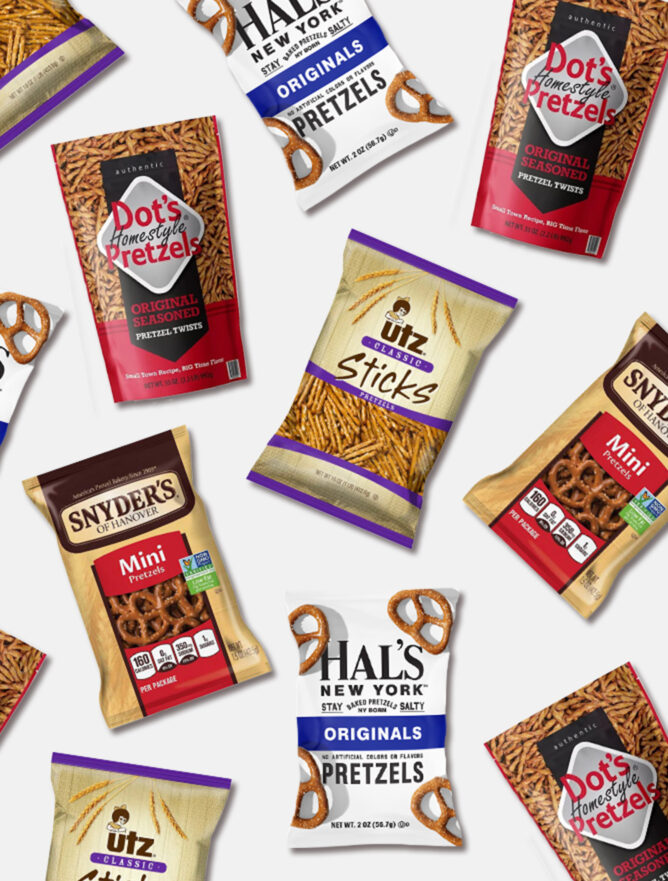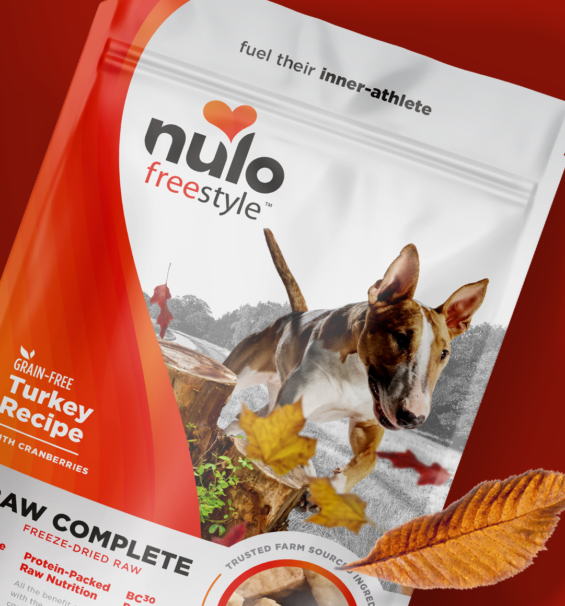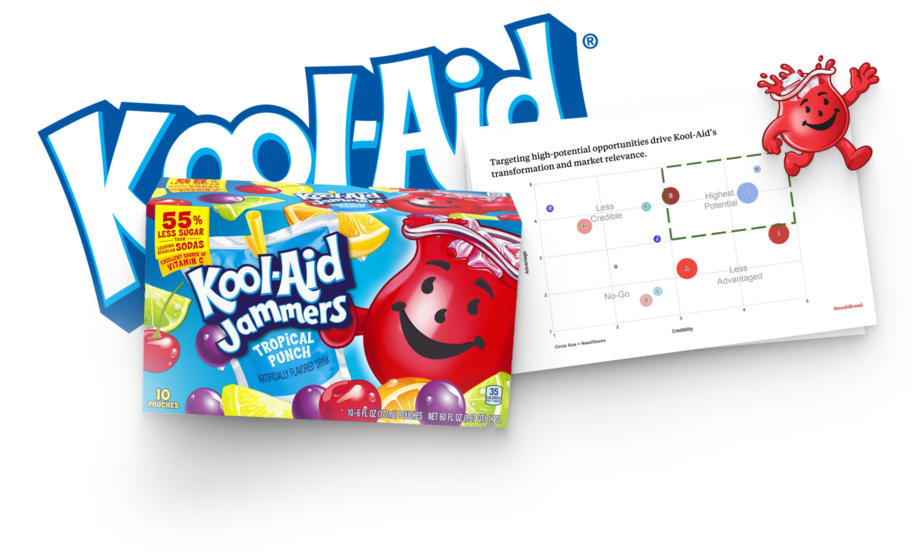Research indicates that approximately 70-80% of new products in the CPG industry fail within the first year. Poorly positioned products, weak packaging designs, or the wrong price points can cost millions and risk brand dilution. Yet, even with such great risks, many companies rely on gut instincts instead of real consumer insights. CPG product development needs more than a good idea with a splash of creativity—it demands data-driven precision.
Successful new product development isn’t just about getting your idea in-market; it’s about launching something that outperforms competitors with the intended target market. The best product managers know that CPG marketing (including the pack design) must be built on what shoppers want, not what a boardroom assumes. That’s where consumer packaged goods brands win—or lose.
By integrating strategy, consumer insights, and iterative testing, leading CPG brands eliminate guesswork, minimize risk, and maximize success. This is how the most innovative companies approach product development—and how yours should, too.
Key pillars of an impactful CPG product.
Creating a winning CPG product takes more than just a great idea. A comprehensive study found that 25% of new SKUs fail within the first year, with cumulative failure rates reaching about 40% by the end of the second year. What separates an industry leader from an average product? It all comes down to strategic decision-making across several core pillars.
Reason to Win
Breaking into the CPG market requires a compelling Reason to Win. This means identifying white space opportunities for emerging brands, leveraging innovative solutions, and addressing consumer pain points established competitors overlook. Success hinges on offering something undeniably better or different, backed by sharp positioning and agile execution.
For established CPG brands, the Reason to Win lies in sustaining relevance. It’s about leveraging brand equity, optimizing the supply chain, and adapting to emerging consumer trends faster than competitors. Strengthening customer loyalty through consistent innovation and differentiated product extensions ensures the brand remains the market leader, not just a trusted name.
Precise and differentiated positioning.
Once the name is locked in, positioning becomes critical. Consumers make snap decisions; if your product doesn’t immediately communicate why it’s better, it will be ignored. A strong, unique selling proposition (USP) defines what makes a product different and why it matters. Industry leaders don’t rely on vague claims—they use data-driven messaging that speaks directly to consumer needs. They ensure the product fits in the right category, resonates emotionally, and creates an apparent reason to buy.
A name that sticks.
A product name is the foundation of brand identity. The best names are simple, memorable, and meaningful. They evoke emotion, align with the brand’s purpose, and stand out in a cluttered marketplace. Consumers need to remember it, pronounce it quickly, and associate it with something positive. A weak or forgettable name makes marketing harder and product recognition nearly impossible.
Packaging that captures attention.
Packaging is the next major battleground. At retail, it’s the only thing standing between a product and a lost sale. It must be designed to capture attention, communicate benefits instantly, and reinforce brand identity. The best brands use packaging as a storytelling tool, leveraging bold visuals, strategic color choices, and clear messaging. But it’s not just about aesthetics—it must also meet retailer requirements, be easy to stock, and fit seamlessly into the supply chain.
An optimized pricing strategy.
Pricing is another key factor. Industry leaders don’t pick numbers randomly—they use consumer research, competitive benchmarking, and perceived value analysis to find the sweet spot. If a product is priced too high, it alienates shoppers. Too low, and it loses credibility or erodes margins. The best brands strike a balance that feels right to the consumer while maintaining profitability and retailer appeal.
A compelling brand story.
Beyond the tangible elements, a compelling brand story drives long-term loyalty. Consumers don’t just buy products—they buy into brands they trust and relate to. A strong narrative builds emotional connections, whether built around sustainability, innovation, or a unique mission. Industry leaders ensure their story is consistent across all touchpoints, from packaging to marketing to social media engagement.
Flawless product performance.
Of course, none of this matters if the product doesn’t deliver. Flawless execution, whether in food, beverages, beauty, or household goods, turns trial into repeat purchases. Leading brands invest in quality control, consistent formulation, and consumer testing to ensure every experience meets expectations. If a product fails to deliver its promise, even the best branding and marketing won’t save it.
Strong distribution & retail strategy.
A robust distribution and retail strategy determines whether a product thrives or fades. Even the most innovative CPG brands fail if they aren’t available on the right shelves. Industry leaders strengthen retailer relationships, streamline supply chain logistics, and adopt an omnichannel fulfillment approach. This ensures product availability across brick-and-mortar stores, direct-to-consumer (DTC) platforms, and significant e-commerce marketplaces, providing a seamless customer experience wherever consumers shop.
However, none of these pillars operate in isolation. Successful CPG brands integrate branding, product development, pricing, and distribution into a unified strategy. A well-executed omnichannel retail strategy leads to a more impactful go-to-market strategy and shapes future marketing efforts.
Steps to a successful CPG product development process.
Bringing a new product to market in the CPG industry is a strategic process that turns consumer packaged goods into retail successes. Every step matters, from R&D and product innovation to refining your marketing strategy and optimizing the supply chain. Staying ahead of CPG trends and embracing CPG innovation ensures your product is positioned to win.
The following are the key steps in a new product development process that transforms ideas into high-performing brands:
Market research and consumer insights.
Every winning CPG product starts with knowing exactly what the consumer wants—even before they do. That’s where consumer insight drives the brand development process, helping CPG marketers uncover gaps in the market. Identifying white space opportunities isn’t about guessing—it’s about using data to pinpoint unmet consumer needs and emerging trends.
An effective brand development strategy analyzes how people shop, what influences their decisions, and what barriers stop them from buying. But understanding consumer goods alone isn’t enough. A CPG company must also study durable goods to see how shifting behaviors impact cross-category purchases.
Then comes competitive benchmarking. A product manager must dissect rival brands—what they say, how they price, and where they fall short. Creative brand development happens when data meets strategy, helping brands position themselves for differentiation. Without deep marketing research, even the best ideas fall flat. This is the foundation of a successful CPG product launch.
Concept development and product positioning.
A great idea isn’t enough; it needs a brand personality development strategy that resonates with the market. This step defines what makes your consumer products different and why they matter.
It starts with crafting a unique value proposition based on each consumer need and predictive analytics. What problem does your product solve? Why should consumers choose it over competitors? Leading CPG manufacturers test multiple concepts to gauge data quality and market fit before proceeding.
Messaging is where everything connects. CPG leaders know that clarity, emotion, and relevance drive conversions. Your packaging design must communicate the right message instantly while aligning with consumer trends. A powerful concept without the proper positioning is a missed opportunity. Effective supply chain management ensures that your vision translates into reality at scale. A McKinsey survey indicates that over 75% of supply chain leaders prioritize digitalization as a key strategy for enhancing resilience and efficiency within their operations.
Packaging and design that drive purchase.
Packaging is the first thing shoppers see; visibility equals sales in the CPG sector. If your product doesn’t stand out, it won’t sell. Market research reveals that consumers make snap decisions, so every design choice must reinforce product differentiation and capture attention instantly.
Clarity wins. A strong messaging hierarchy ensures key benefits don’t get lost in clutter. Consumers don’t read—they scan. They’ll choose another if they can’t instantly understand what makes your product better.
But design isn’t just visual. The CPG innovation process demands packaging that meets retail requirements and improves the customer experience. Materials, durability, and structure must work in product development while aligning with retailer expectations. Consumer packaged goods companies that master both aesthetics and function don’t just get noticed—they get bought.
Pricing strategy & retail readiness.
If the price is too high, you lose customers. If it’s too low, you kill margins. Choosing the correct number is a calculated decision backed by consumer testing. Innovative brands analyze willingness to pay, competitor benchmarks, and perceived value to lock in the optimal price point before launch.
Retailers have their priorities. Your product must fit within their pricing structure while leaving enough margin for profitability. Meeting supply chain efficiencies and shelf requirements is critical to hitting a CPG trend. If buyers don’t see a win, they won’t stock it.
Selling in multiple channels requires precision. Product brand development for retail isn’t the same as ecommerce. Online shoppers compare prices instantly, while in-store buyers make impulse decisions. A solid marketing strategy ensures consistency while optimizing for each platform. Brands that master CPG innovation own their space instead of just competing.
Consumer testing and iteration.
Most product failures could have been prevented with better testing. CPG manufacturers that wait until launch to validate concepts are already too late. Early and frequent testing reveals what works, what doesn’t, and what needs refinement—before it costs millions.
Behavioral science takes this further by simulating real-world shopping environments. Consumers don’t buy based on what they say in surveys; they buy based on instinct. Predictive analytics tracks actual purchase behaviors, ensuring data isn’t just theoretical—it’s actionable.
Subjectivity kills good products. Complex product data removes ego from the equation, letting brands optimize packaging design, messaging, and price based on facts, not opinions. Aligning with consumer trends ensures relevance, while strong data quality drives better decisions. Visionary CPG leaders refine, test, and refine again. Those who don’t? They let retailers and shoppers do the testing for them—at their own expense. Supply chain management can’t fix a flawed product from the start.
Launch execution and performance tracking.
A strong launch means nothing if the product doesn’t move. Driving trial and repeat purchases requires more than shelf placement—it demands consumer insight, strategic promotions, and relentless execution. Successful brand managers know first-time buyers won’t return unless the experience delivers.
Once the product hits shelves, the real work begins. Post-launch data analysis tracks sales velocity, customer feedback, and adoption rates. Product data and analytics reveal what’s working and what’s not. If the numbers don’t meet expectations, something needs to change—fast.
Optimization never stops. Market research uncovers shifts in consumer trends, guiding tweaks to packaging design, messaging, or pricing. Sometimes, the issue isn’t the product; it’s how it’s positioned. R&D teams and digital transformation tools refine strategies, while supply chain management ensures changes roll out smoothly. Even in durable goods and consumer products, brands that track, adapt, and execute relentlessly are the ones that survive.
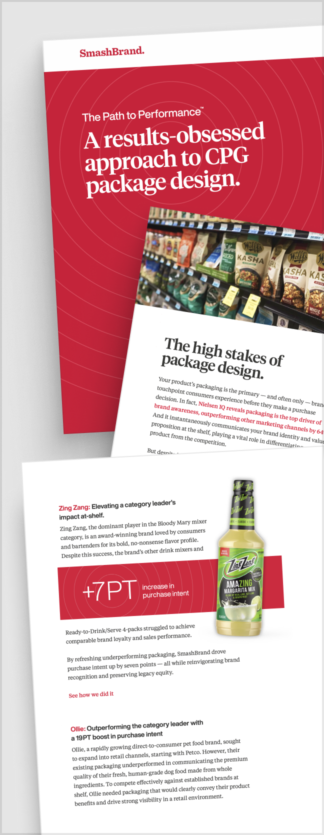
Path to Performance™
Taking a results-obsessed approach to CPG package design.
Learn how SmashBrand’s proprietary process – rooted in scientific principles, informed by data, and validated by your target audience – takes the guesswork out of package design and delivers guaranteed results.
"*" indicates required fields
Common pitfalls in CPG product development.
Even the best ideas fail when execution falls short. Here’s where most brands go wrong and how to fix it.
Relying on internal opinions instead of consumer data: What a team believes about a product doesn’t matter—what consumers do does. Brands that skip real-world testing risk launching products no one wants. Data-driven decisions, not assumptions, separate winners from failures.
Weak product positioning that doesn’t differentiate: It gets lost if your product doesn’t stand out. Vague messaging, generic benefits, and poor category fit confuse shoppers. Positioning should be precise, unique, and impossible to ignore.
Packaging that doesn’t grab attention or communicate value: Consumers scan shelves in seconds, so packaging must command attention and immediately tell them why to buy. Strong visuals and hierarchy ensure that key benefits are noticed.
Pricing that misaligns with consumer expectations: Price too high, and shoppers walk away. Too low, and margins suffer. Pricing must balance perceived value, competitive benchmarks, and profitability.
Skipping retailer considerations and failing to secure shelf space: Retailers have their priorities. If your product doesn’t fit its margins, planograms, or strategy, it won’t reach shelves. Align with retailer expectations from day one.
Launching without validating purchase intent: What consumers say they’ll buy and what they buy aren’t the same. Testing in real-world conditions eliminates false confidence and costly missteps.
Ignoring post-launch performance tracking and optimization: A product launch isn’t the finish line—it’s the start. Without ongoing data analysis, minor problems become significant failures. Brands that track, learn, and refine stay ahead.
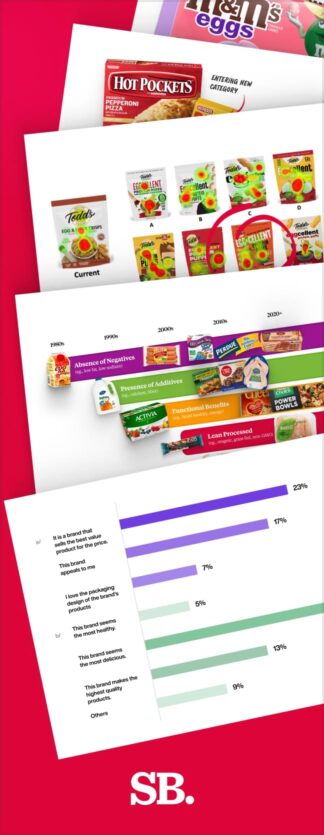
Nice Package
Don’t miss out on our monthly newsletter Nice Package!
Each month, we deliver a data-driven newsletter directly to your inbox, unpacking a critical topic in the FMCG & CPG industry.
"*" indicates required fields
How SmashBrand eliminates risk and maximizes CPG success.
Most agencies focus on creativity, while SmashBrand focuses on winning in retail. By integrating strategy, design, and testing under one roof, brands eliminate inefficiencies and ensure data-driven decisions. Cross-functional collaboration streamlines execution, reducing costly missteps.
With PREformance® Testing, every product is validated before launch. SmashBrand simulates purchase behavior, testing large sample sizes to ensure statistical accuracy. Iterative refinement guarantees that only market-ready products reach shelves.
Packaging isn’t just about aesthetics—it’s about performance. SmashBrand uses data to craft designs that capture attention, communicate instantly, and drive conversions. Every element is optimized for in-market success.
The results? Guaranteed performance. SmashBrand has helped brands achieve higher sales velocity, solid retail acceptance, and category dominance. There is no guesswork, no wasted budgets—just CPG products built to win.
Subscribe to
Nice Package.
A monthly newsletter that unpacks a critical topic in the FMCG & CPG industry.
Free Resource.
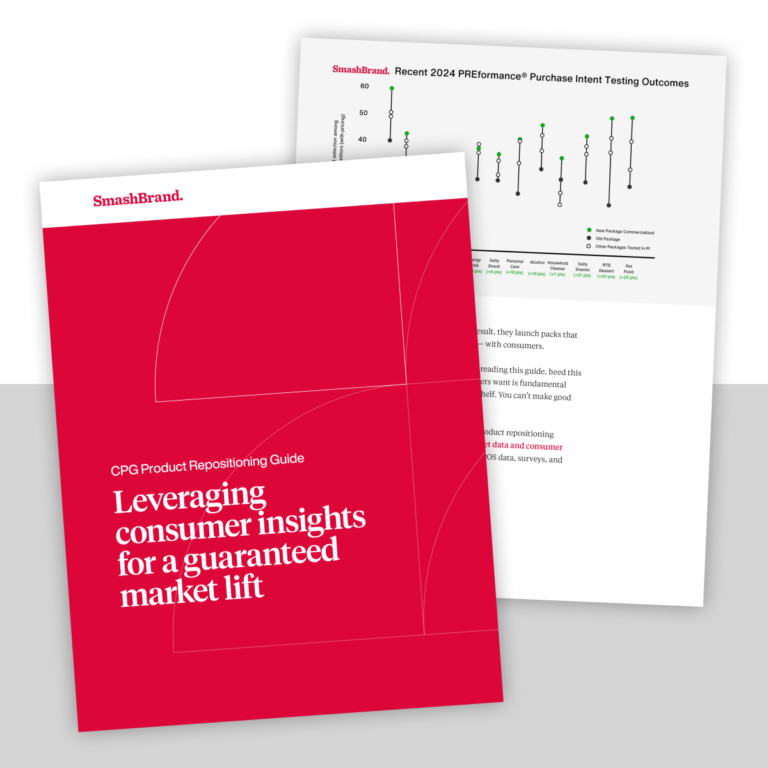
CPG product repositioning guide.
Explore the five undeniable signs your CPG product needs repositioning along with strategies for leveraging consumer insights for a guaranteed market lift.
Learn More About CPG product repositioning guide.
